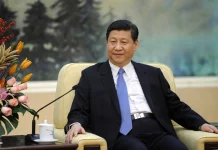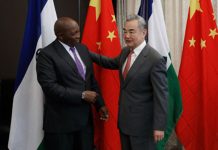BEIJING: Here is a chance for a glimpse into the development path of the world’s second-largest economy in the years to come. The world has been watching the third plenary session of the 20th Central Committee of the Communist Party of China mapping out the country’s blueprint. On CGTN Radio podcast Deep Dive, host Liu Kun spoke to reporter Dou Hongyu for first-hand information of China’s reform agenda and economic policy as well as their far-reaching impacts on the country and beyond.
Q: First, tell us more about the plenary meetings of the CPC Central Committee and why does the third plenary meeting get the most attention from investors and the public?
The Communist Party of China holds its biggest meeting, the National Congress, every five years. A new Central Committee is formed during the National Congress.
The Central Committee, which is the top governing body of the Communist Party, holds seven plenary sessions over a five-year term. Each has different focuses.
Normally, the first and second plenums deal with fixed procedures, such as power transitions and leadership appointments, not decision making on key policies. The third plenum produces policies that could change the direction of the Chinese economy. The fourth focuses on party building. The fifth plenary meeting forms“Five-Year Plans” for China’s national economic and social development. The sixth plenum deals with ideological matters. The seventh makes final preparations and announces the dates for the next Party Congress.
The reason why the third plenums get the most attention is that it is usually where the CPC announces its big picture plans over the next five or ten years. So it gives you a glimpse into the near future of China, especially the economic development, which is an important source of information for investors. It represents the first chance for the new leadership to introduce its thinking on economic and political issues.
The third plenary sessions are held every five years on average. So each one was held under different international landscape and with different domestic problems.
This year, in particular, investors are watching closely for any hints on policy direction to address problems including those related to real-estate, youth employment, and consumer confidence.
Q: How effective have the third plenums been in guiding reform in the past?
The past third plenums have delivered historic reforms. There are quite a lot of examples, but let’s focus on the latest 10 years, because since the reform and opening-up started in 1978, China’s growth of GDP has shocked the world, but the development was described as “unbalanced, uncoordinated and unsustainable.” And as the reform deepens, more and more hard bones have been exposed and they are the target of reform in the past decade and in the years to come.
In 2013, the 18th Central Committee’s third plenum released “The Decision on Major Issues Concerning Comprehensively Deepening Reforms.” It has 16 chapters, and that was an epoch-defining set of changes, including market-oriented reform measures, the relaxation of the country’s one-child policy, and a change of household registry system.
Let’s take a look at the reform on state-owned enterprises, which is one of the hardest bones among all the reforms.
Take the example of China First Heavy Industries Group, which was founded in 1954. It is the legacy of the Soviet style industrial model and was known as the pillar of the country’s heavy machinery production in the planned economy era. But it began to crumble as China stepped into a market economy. Especially, with an inefficient management system, in the 1980s, the company was not as productive and innovative as private firms and suffered from over-capacity and debt.
The third plenary session of the 18th CPC Central Committee stressed on the reform on SOEs. Following that, the China First Heavy Industries Group was quite serious about motivating employees. For instance, in one of the subsidiaries, the whole management team was removed, because it failed to meet the target for several years. The group gave every employee the opportunity to compete for a post in the management. It sounds simple but it was actually a difficult and brave move because it broke the vested interests of many in the leadership.
But fortunately the reform has already started to pay off. Early this year, it produced the largest hydrocracker reactor ever in the world. It wouldn’t come true with the original rigid and inefficient management and the lack of creativity before the third plenum of the 18th CPC Central Committee.
Reforms also took place in other fields following the meeting over the past decade, including taxation, environmental protection, democracy and the medical systems.
The following 3rd plenum of the 19th CPC Central Committee in 2018 was very special as it adopted a decision on deepening reform of Party and state institutions. That was commented as out of expectation and unprecedented. Of course there were many other problems to be solved, such as environmental degradation, the lack of creativity, and there were also problems with people’s livelihoods. But to solve these problems the country needed to improve its governing capability, and it had to start with the restructuring of Party and state institutions to make them more efficient.
For example, the Ministry of Agricultural Affairs was founded in the year of the meeting. Before that, if you were in charge of an agricultural investment project, you had to shuttle among multiple departments involved in different stages of the project, such as the Ministry of Agriculture, the National Development and Reform Commission, and the Ministry of Finance. But now all those responsibilities have been gathered at the new ministry, the Ministry of Agricultural Affairs, which is way more efficient, and has avoided different departments from shifting responsibilities to each other. So the third plenum of the 19th CPC Central Committee in 2018 is seen as an important point of time when many major problems of the country started to be solved top down. So countless powerful reforms actually started from the third plenums.
Q: Some say the third plenary meetings of the CPC Central Committee act as a beacon for China’s overall development. Could you explain why?
The ultimate purpose of the meetings is for the country to develop. In the course of development, the economic base shapes social and political structures such as politics, culture, law, and ideology. And the social and political structures in turn affect economic activities. Sometimes there are contradictions between the policies and what the society really needs.
For example, the third plenums of the previous CPC Central Committee before 2013 mainly focused on economic growth because that was the most urgent need of the era. But by 2012, many national policies were faced with tough challenges. For example, the gap in wealth and income widened, which led to increased social dissatisfaction that added to social instability. Another challenge was that the environmental problems were neglected during the high-speed economic growth.
So, starting from the term of the 18th CPC Central Committee, the mode of China’s development has switched from a development-oriented one to a model that balances development and governance.
So the role of the third plenary sessions is to point out reform directions to achieve healthy coordination between the economic system and the superstructure.
Q: What message do you read from this week’s meeting in terms of China’s reform, opening up, economic development?
Two words: ambition and determination. The session released a communiqué saying that it adopted a resolution on further deepening reform comprehensively to advance Chinese modernization. There are two major differences between this title and that of the decision in 2013. First, further deepening reform which means that reform in all walks of life in China will be pushed forward; and second, the purpose is to advance Chinese modernization, which is a new term. The resolution is quite an ambitious plan with over 5000 characters in the communiqué covering 14 aspects including governance, economy, opening-up, democracy, education, etc. You can also feel the determination from the communiqué which said the reform tasks laid out in the resolution shall be completed by the time the People’s Republic of China celebrates its 80th founding anniversary in 2029. So there is a timeline, which means Chinese modernization is not rhetoric, and China is very serious about it.
This is the first time that Chinese modernization was mentioned and stressed by the third plenum of a CPC Central Committee. This term was proposed by the Party Congress of the 20th CPC Central Committee about two years ago. So this week’s meeting is also the first time that the party leadership signaled concrete reforms to achieve it.
In the past when we talked about Chinese modernization, we always talked about its five characteristics, namely, modernization of a huge population, common prosperity for all, material and cultural-ethical advancement, harmony between humanity and nature, and peaceful development.
Now the meeting shows us how the five characteristics manifest themselves in reality. For example, the reforms include integrated development of urban and rural areas and improving the income distribution system. That is part of the efforts to achieve common prosperity for all, the second characteristic of Chinese modernization.
So if Chinese modernization is a house to build, the five characteristics are like a general picture of it, but this week’s meeting is a construction drawing. It gives us a chance to zoom in to take a closer look at what Chinese style of modernization is. It makes the picture clearer not only to people in China but also to the world who wants to know where China is headed to.
Q: How does this meeting define the status quo of China’s economy in response to concerns expressed by some western media?
I’ve read and watched a lot of reports from western media on this week’s meeting and I feel like for them it is a great chance to remind people of all the challenges China is facing. And they are still trying to say Chinese economy has reached a peak and there are not many effective solutions.
The meeting has naturally debunked the “China peaks” narrative by the west. It didn’t have to do it on purpose. The “China peaks” theory sounds new but it is the same as the so-called “End of China’s economic miracle” theory back in 2013 when the third plenary session of the 18th CPC Central Committee was held. As we have discussed, enormous reforms have taken place over the following decade. Last year, China’s GDP surpassed 126 trillion yuan, over 17 trillion US dollars, more than double that of 2013. So it eventually scotched the narrative of “End of China’s economic miracle.”
From this week’s meeting, we can see that the collapse of the 2013 narrative will happen again, but this time with the “China peaks” narrative. The meeting has told us how the narrative will collapse with massive reform plans.
For example, the communiqué says the country will improve the institutions and mechanisms for fostering new quality productive forces in line with local conditions.
In one of our episodes this March, we talked about the smart drive in China’s manufacturing industry. We discussed how digital and smart technologies in some of the world’s most advanced smart factories in China increase productivity and reduce costs of time, money and energy. The digitization drive and the application of smart technologies is part of the efforts to foster new quality productive forces. China has already been doing this but now it is mostly large companies and factories that have completed their smart transformation. Now the country is encouraging medium and small-sized companies to follow suit. With the reform missions released by this week’s third plenum, I’m personally looking forward to the smart drive sweeping across China. This will be a growth driver in the years to come. Transformation in other fields will also take place following the meeting, and the problems mentioned by the western media will be tackled with concrete measures.
Q: What challenges facing China’s development have been mentioned at this week’s meeting? Is there any solution to address the challenges?
The reform plans in the resolution adopted by the meeting are actually solutions to address the challenges in China, especially the imbalances in China’s development, such as growth and inequality, and economic development and environmental protection. The directions of the reform are clear, as stated in the communiqué, such as how to improve social justice and how to tackle climate change. When these reform ambitions reach the ground, they will evolve into concrete measures based on local conditions.
Q: How will this week’s meeting impact the world’s economies?
It’ll mean a lot to global investors. For example, it has been reported that a group of executives from large American companies will come to Beijing next week, just following the meeting. Some on the list of the visiting companies includes Goldman Sachs, Starbucks, Honeywell and Nike. They hope to meet with senior Chinese officials to get first-hand information on China’s future development roadmap. So investors are planning to adjust their strategies on the Chinese market to capitalize on the policy changes to take place in China as well as the economic growth in the country.
The meeting will also probably have a profound impact on countries striving for their own paths of modernization. Part of the underlying logic of Chinese modernization is that modernization doesn’t equal to westernization, so each country can have their own way of solving their own problems. The reform measures released at this time are part of the reform and opening-up starting from 1978, so many of them are still like crossing the river by feeling for the stones. Numerous lessons can be learned from the new measures and what China is going to do. President Xi Jinping said that Chinese modernization can set “a good example for developing countries to move towards modernization independently and has provided them with a new choice.”
So the meeting in the second largest economy will not only be transformative in the country, but also make a huge difference on the global economic outlook. –The Daily Mail-CGTN news exchange item




